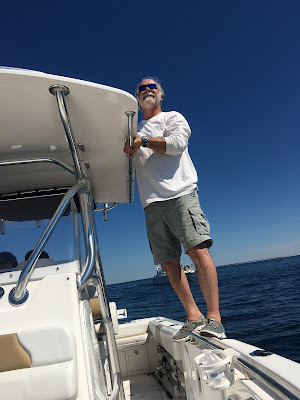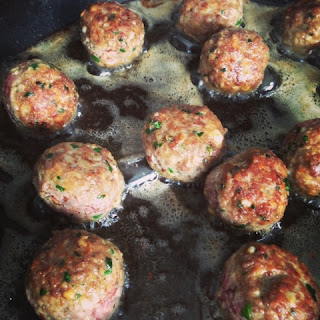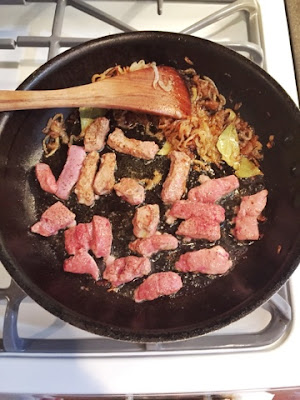Dad: Why do you go to school?
Me: To get good grades.
Why do you want good grades?
To get into a good college.
Why do you want to go to a good college?
To get a good job.
And finally: Why do you want a good job?
So I can take care of my dear old dad.
He had me well trained at a very young age.
This was our Saturday morning ritual. Listening to Jim Croce, we’d practice this father/daughter mantra and go on our dump run (some of you know, we danced to Rapid Roy at my wedding). We’d stop for coffee and Nintendo at Mark and Cherie’s, pick up a few brownies at Elm Farm Bakery and go down to the river. Then we’d come home and make hot dogs and beans. This was us. This was Saturday.
My dad was a great man. But he would say he was a just a man with a great life. He would insist, “Nina, I live a charmed life”. And he did. Whether it was getting the very last parking spot in a crowded lot in Boston or the moment he learned he was going to be a Babbo. Even at the end. Even when we cried tears and tears together, called bullshit and wondered if the charm had finally run out.
Paul Kostecki loved his life. He loved his family. He loved his friends. He loved singing at the top of his lungs in his truck to the songs that made him, him. He was perpetually moving to the soundtrack of his life- Bob Dylan, James Taylor, Jim Croce, Jimmy Buffet, his beloved Eagles, Arlo Guthrie- storytellers all. Always in motion, my dad moved towards happiness, towards fixing problems, towards helping out a friend, towards joy and ultimately, towards gratitude for his collection of beautiful people and the memories they made together.
For dad, the journey was more important than the destination. Many of you had the pleasure of eating my dad’s bouillabaisse. It was his signature dish- a bowl filled to the brim with seafood and shellfish. No meal made him happier to eat. But the happiest part of Dad’s bouillabaisse was in the planning. He’d want to talk about the ingredients, discuss at length what changes he wanted try (Pancetta this time! Shallots, not onions!). Going to the store with him to purchase the seafood was a special experience. He would buy it ALL. For him the joy was in the journey it took to get to the table to sit down and eat.
Anyone who knew Paul Kostecki knew that he walked through fire for his people, especially for his kids. But maybe you didn’t know, he would also (try) to walk on water. One year at Nonna’s Cottage, Tom and I were sailing a small sunfish and per usual, sailing it badly. We capsized in the middle of the lake. We were in no immediate danger- both for us were in life jackets with decent swimming skills but we couldn’t tip the boat back up so we resorted to dragging her in. All of sudden we hear “IT’S OKAY NIN, I’M COMING, IT’S OKAY”. We look over to see dad yelling his head off and dragging an aluminum tin can, disguised as a canoe into the water. He takes a running leap into the canoe and begins wildly paddling towards us. He was in exactly two feet of water when HE capsized (not wearing a life jacket and not being a decent swimmer). He didn’t care. I was treading water in the middle of the lake and he was going to save me damnit.
He capsized a second time about five feet from the first spot, by which point we had righted the boat and were sailing into the dock when WE capsized for the last time. The entire lake was watching this failed rescue unfold in hysterics. But if my dad couldn’t walk through fire to get to us, he damn well was going to take a boat to do it.
The Paul Kostecki everyone spoke about today is a colorful, accurate and beautiful collage of the different moments that made up his life. But I’d like to tell you about his best year. His most courageous year. His last year. I call it his best year because there is no greater test of one’s character than to realize your time on this earth is ending. My dad was not afraid to die. He looked at his illness as part of his journey. And he did what he always did- made sure our family had what we needed to keep moving forward, towards the joy.
In those last days, Dad whispered to me “maybe the charm’s worn out”. I whispered back “how could it have worn out, I’m a Kostecki and my life is pretty damned charmed. Dad, you gave me your tools”.
I can never hope to fill the void my dad’s physical absence has left us with. But I can be a person who fixes problems. I can sing at the top of my lungs while driving. I can teach my daughter how to properly swear and show her how to always turn towards gratitude.
I now understand the answers my dad was trying to teach me as a four year old enjoying bites of a brownie by the river.
Why do you go to school?
You go to school because learning makes you curious and if you stay curious you experience so much.
Why get good grades?
Good grades give you good options. They help you make good choices. And you are always responsible for the choices you make.
Why go to a good college?
Because if you’re very lucky, your dad will be the one to hand you your diploma.
Why get a good job?
A good job gives you purpose and joy.
And why take care of your dear old dad?
Because taking care of the ones you love the most will fill you with gratitude and countless memories. It will make you rich. And it will show you how to live a charmed life.
I will love you beyond forever, Dad.
Paul Kostecki's Obituary




























